

Crash Course Chapter 8: The Fed - Money Creation - Crash Course Videos at Chris Martenson - credit, Debt, Federal Reserve, interest, loans, money creation, perpetual expansion, the Fed, Treasury bonds. Now we’re going to discover where money is created.

The process works like this. Suppose Congress needs more money than it has. I know, that’s a stretch! Perhaps it has done something really historically foolish, like cutting taxes while conducting two wars at the same time. Now, Congress doesn’t actually have any money, so the request for additional spending gets passed over to the Treasury Department. You may be surprised, or dismayed, or perhaps neither, to learn that the Treasury Department lives hand-to-mouth and rarely has more than a couple of weeks’ of cash on hand, if that. THE HISTORY OF MONEY Rothschild Banking. Money As Debt(日本語字幕版) Gold standard. All references to "dollars" in this article refer to the United States dollar, unless otherwise stated.
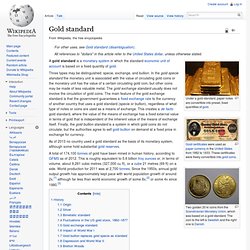
Coinage1792. MONEY LAW The Coinage Act of April 2, 1792 (1 Stat. 246) Statute I.
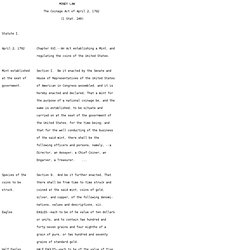
Inflationinonepage. Inflation - part 2/2. In part 1 we saw that defining inflation as generally rising prices is a red herring.

We argued that the definition is meaningless because it cannot be objectively determined. However, rising prices are a phenomenon we observe today, and one that greatly impacts our lives. Ultimately, our goal is to explain rising prices. It is insufficient to simply deconstruct the mainstream view of inflation, we must offer an alternate theory, one that hopefully better explains price movements.
Supply Shocks and Water Levels Mainstream economists usually attribute inflation to supply shocks (cost-push), increased aggregate demand (demand-pull), or other exogenous circumstances. Consider the following thought experiment. Too Much Money Chasing Too Few Goods Let us continue with our thought experiment. Many mainstream economists recognize this. Our thought experiment demonstrates that a rise in prices is essentially too much money sloshing around the system chasing too few goods.
Inflation - part 1/2. Many people will be surprised to learn that the dollar today is worth only 4 cents of a dollar in 1913 when the Federal Reserve, created for the stated purpose of fighting inflation and managing unemployment, was issued the charge of creating the nations currency.
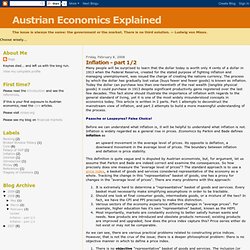
The process by which the dollar has gradually lost value (buys fewer and fewer goods) is known as inflation. Today the dollar can purchase less than one-twentieth of the real wealth (tangible physical goods) it could purchase in 1913 despite significant productivity gains registered over the last few decades. Jeckyll Island and the Federal Reserve. By John Pounders, Paradigm Publishing, Copyright 1996 My wife and I visited Jekyll Island, Georgia, in April, 1996.
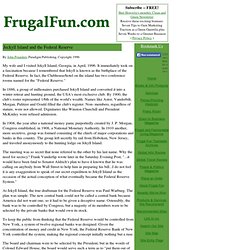
It immediately took on a fascination because I remembered that Jekyll is known as the birthplace of the Federal Reserve. In fact, the Clubhouse/hotel on the island has two conference rooms named for the "Federal Reserve. " In 1886, a group of millionaires purchased Jekyll Island and converted it into a winter retreat and hunting ground, the USA's most exclusive club. G. Edward Griffin on the Federal Reserve System. Fractional Reserve Banking. Fractional Reserve Banking by Murray N.
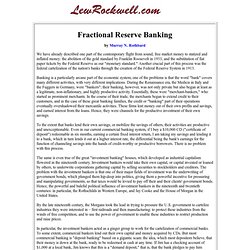
Rothbard. Fractional-reserve banking. Fractional-reserve banking is the practice whereby a bank holds reserves in an amount equal to only a portion of the amount of its customers' deposits to satisfy potential demands for withdrawals.
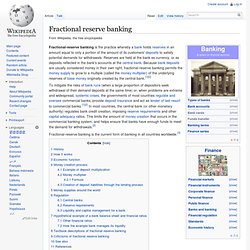
Federal Reserve System. History of Fiat Money. In a fiat money system, money is not backed by a physical commodity (i.e.: gold).

Instead, the only thing that gives the money value is its relative scarcity and the faith placed in it by the people that use it. A good primer on the history of fiat money in the US can be found in a video provided by the Mises.org website. In a fiat monetary system, there is no restrain on the amount of money that can be created. This allows unlimited credit creation. Initially, a rapid growth in the availability of credit is often mistaken for economic growth, as spending and business profits grow and frequently there is a rapid growth in equity prices. History of money. Many things have been used as medium of exchange in markets including, for example, livestock and sacks of cereal grain (from which the Shekel is derived) – things directly useful in themselves, but also sometimes merely attractive items such as cowry shells or beads were exchanged for more useful commodities.
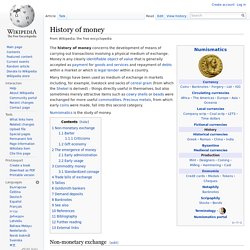
Precious metals, from which early coins were made, fall into this second category. Numismatics is the study of money. Non-monetary exchange[edit] Barter[edit] In Politics Book 1:9[1] (c.350 B.C.) the Greek philosopher Aristotle contemplated on the nature of money. With barter, an individual possessing any surplus of value, such as a measure of grain or a quantity of livestock could directly exchange that for something perceived to have similar or greater value or utility, such as a clay pot or a tool. Criticisms[edit] In his book Debt: The First 5000 Years, anthropologist David Graeber argues against the suggestion that money was invented to replace barter. Gift economy[edit]